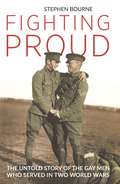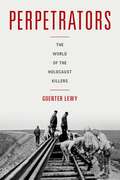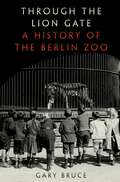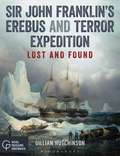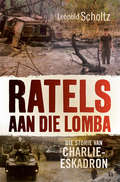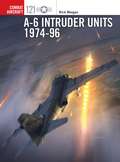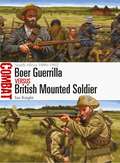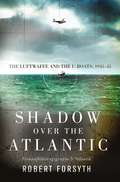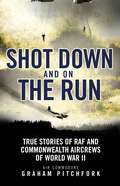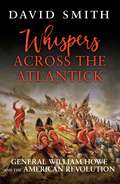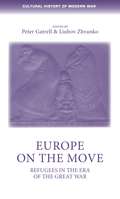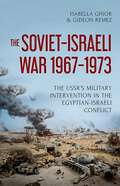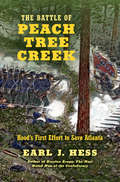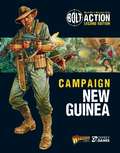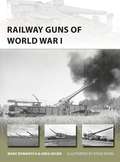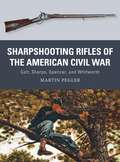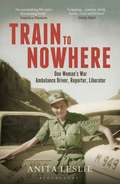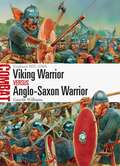- Table View
- List View
Storm of Eagles: The Greatest Aviation Photographs of World War II
by John Dibbs Kent Ramsey Robert Cricket" RennerSoaring high above the fields and cities of Europe and Asia as well as the vast expanse of the Pacific, Allied and Axis pilots engaged in a deadly battle for control of the skies in World War II. Whoever won the skies would win the war.Published in association with the National Museum of World War II Aviation, Storm of Eagles is a fully illustrated coffee-table book that brings together classic as well as never-before-seen wartime images. Compiled by one of the world's premier aviation photographers and historians, this remarkable volume is a must-have for anyone interested in World War II aviation.
Fighting Proud: The Untold Story of the Gay Men Who Served in Two World Wars
by Stephen BourneIn this astonishing new history of wartime Britain, historian Stephen Bourne unearths the fascinating stories of the gay men who served in the armed forces and at home, and brings to light the great unheralded contribution they made to the war effort. Fighting Proud weaves together the remarkable lives of these men, from RAF hero Ian Gleed - a Flying Ace twice honoured for bravery by King George VI - to the infantry officers serving in the trenches on the Western Front in WWI - many of whom led the charges into machine-gun fire only to find themselves court-martialled after the war for indecent behaviour. Behind the lines, Alan Turing's work on breaking the 'enigma machine' and subsequent persecution contrasts with the many stories of love and courage in Blitzed-out London, with new wartime diaries and letters unearthed for the first time. Bourne tells the bitterly sad story of Ivor Novello, who wrote the WWI anthem 'Keep the Home Fires Burning', and the crucial work of Noel Coward - who was hated by Hitler for his work entertaining the troops. Fighting Proud also includes a wealth of long-suppressed wartime photography subsequently ignored by mainstream historians.This book is a monument to the bravery, sacrifice and honour shown by a persecuted minority, who contributed during Britain's hour of need.
Perpetrators: The World of the Holocaust Killers
by Guenter Lewy"Monsters exist, but they are too few in number to be truly dangerous. More dangerous are the common men, the functionaries ready to believe and to act without asking questions." Primo Levi's words disclose a chilling truth: assigning blame to hideous political leaders, such as Hitler, Himmler, and Heydrich, is necessary but not sufficient to explain how the Holocaust could have happened. These leaders, in fact, relied on many thousands of ordinary men and women who made the Nazi machine work on a daily basis--members of the killing squads, guards accompanying the trains to the extermination camps, civilian employees of the SS, the drivers of gas trucks, and the personnel of death factories such as Auschwitz. Why did these ordinary people collaborate and willingly become mass murderers? In Perpetrators: The World of the Holocaust Killers, Guenter Lewy tries to answer one of history's most disturbing questions. Lewy draws on a wealth of previously untapped sources, including letters and diaries of soldiers who served in Russia, the recollections of Jewish survivors, archival documents, and most importantly, the trial records of hundreds of Nazi functionaries. The result is a ghastly, extraordinarily detailed portrait of the Holocaust perpetrators, their mindset, and the motivations for their actions. Combining a rigorous historical analysis with psychological insight, the book explores the dynamics of participation in large-scale atrocities, offering a thought-provoking and timely reflection on individual responsibility for collective crimes. Lewy concludes that the perpetrators acted out of a variety of motives--a sense of duty, obedience to authority, thirst for career, and a blind faith in anti-Semitic ideology, among others. A witness to the 1938 Kristallnacht himself and the son of a concentration camp survivor, Lewy has searched for the reasons of the Holocaust out of far more than theoretical interest: it is a passionate attempt to illuminate a dismal chapter of his life--and of human history--that cannot be forgotten.
Through the Lion Gate: A History of the Berlin Zoo
by Gary BruceIn 1943, fierce aerial bombardment razed the Berlin zoo and killed most of its animals. But only two months after the war's end, Berliners had already resurrected it, reopening its gates and creating a symbol of endurance in the heart of a shattered city. As this episode shows, the Berlin zoo offers one of the most unusual--yet utterly compelling--lenses through which to view German history. This enormously popular attraction closely mirrored each of the political systems under which it existed: the authoritarian monarchy of the kaiser, the Weimar Republic, Nazi Germany, and the post-1945 democratic and communist states. Gary Bruce provides the first English-language history of the Berlin zoo, from its founding in 1844 until the 1990 unification of the West Berlin and East Berlin zoos. At the center of the capital's social life, the Berlin zoo helped to shape German views not only of the animal world but also of the human world for more than 150 years. Given its enormous reach, the German government used the zoo to spread its political message, from the ethnographic display of Africans, Inuit, and other "exotic" peoples in the late nineteenth century to the Nazis' bizarre attempts to breed back long-extinct European cattle. By exploring the intersection of zoology, politics, and leisure, Bruce shows why the Berlin zoo was the most beloved institution in Germany for so long: it allowed people to dream of another place, far away from an often grim reality. It is not purely coincidence that the profound connection of Berliners to their zoo intensified through the bloody twentieth century. Its exotic, iconic animals--including Rostom the elephant, Knautschke the hippo, and Evi the sun bear--seemed to satisfy, even partially, a longing for a better, more tranquil world.
Sir John Franklin’s Erebus and Terror Expedition: Lost and Found
by Gillian HutchinsonIn 1845, British explorer Sir John Franklin set out on a voyage to find the North-West Passage – the sea route linking the Atlantic Ocean to the Pacific. The expedition was expected to complete its mission within three years and return home in triumph but the two ships, HMS Erebus and HMS Terror, and the 129 men aboard them disappeared in the Arctic. The last Europeans to see them alive were the crews of two whaling ships in Baffin Bay in July 1845, just before they entered the labyrinth of the Arctic Archipelago. The loss of this British hero and his crew, and the many rescue expeditions and searches that followed, captured the public imagination, but the mystery surrounding the expedition's fate only deepened as more clues were found. How did Franklin's final expedition end in tragedy? What happened to the crew? The thrilling discoveries in the Arctic of the wrecks of Erebus in 2014 and Terror in 2016 have brought the events of 170 years ago into sharp focus and excited new interest in the Franklin expedition. This richly illustrated book is an essential guide to this story of heroism, endurance, tragedy and dark desperation.
Ratels aan die Lomba: Die storie van Charlie-eskadron
by Leopold ScholtzOp 3 Oktober 1987 het Charlie-eskadron - die ystervuis van 61 Gemeganiseerde Bataljongroep - op die Lombarivier in die suide van Angola teen 'n veel groter Angolese mag met beter wapentuig as hulle te staan gekom. Tenks is veronderstel teen tenks aangewend moes word. Tog moes die jong dienspligtiges die Angolese tenks van 47 Brigade in Ratels met minder kragtige kanonne en dun pantser aanvat. Boonop was die terrein so dig bebos dat hulle net enkele meter ver kon sien en moeilik kon beweeg.Leopold Scholtz se beskrywing van hierdie Dawid teen Goliat-geveg tydens Operasie Moduler neem die leser na die hart van die aksie. Danksy onderhoude met veterane en dagboekinskrywings dra hierdie intense hervertelling die volle drama van die geveg en ander ervarings aan die front oor. Dit is 'n diep menslike verhaal oor hoe individue reageer in die aangesig van die dood en ook hoe die oorlog hulle nooit uit sy kloue gelaat het nie...
A-6 Intruder Units 1974-96 (Combat Aircraft)
by Jim Laurier Rick Morgan Gareth HectorIn the three decades following Vietnam, the veteran A-6 Intruder remained the most powerful strike aircraft available to the US Navy and Marine Corps. Engaged in operations over Cambodia, Lebanon and Libya during the 1970s and 80s, the A-6 maintained its reputation as the 'Main Battery' of carrier aviation, remaining in service through the First Gulf War up until 1996 when its duties were taken over by the F-14 Tomcat. Following on from his study of the A-6 Intruder's exploits during the Vietnam War, Rick Morgan details the technological developments that were introduced to the airframe after that conflict and how it shaped the operational employment of the aircraft. Filled with first-hand accounts from pilots and navigators, as well as profile artwork and photographs, this is the complete story of the US Navy's main medium attack aircraft in the latter part of the Cold War.
The Bar Kokhba War AD 132–135: The last Jewish revolt against Imperial Rome (Campaign)
by Peter Dennis Lindsay PowellIn AD 132, Shim'on Ben Koseba, a rebel leader who assumed the messianic name Shim'on Bar Kokhba ('Son of a Star'), led the people of Judaea in open rebellion, aiming to establish their own independent Jewish state and to liberate Jerusalem from the Romans. During the ensuing 'Bar Kokhba War' (AKA the Second Jewish War), the insurgents held their own against the crack Roman troops sent by Emperor Hadrian for three-and-a-half years. The cost of this rebellion was catastrophic: hundreds of thousands of casualties, the destruction and enslavement of Jewish communities and a ban on Jews entering Jerusalem. Bar Kokhba remains important in Israel today because he was the last leader of a Jewish state before the rise of Zionism in modern times.This fully illustrated volume explores the gripping story of the uprising, profiling its rebel leader Bar Kokhba as well as the Emperor Hadrian and his generals, and assesses the impact that this violent rebellion had on the region and those that were displaced.
Boer Guerrilla vs British Mounted Soldier: South Africa 1880–1902 (Combat)
by Johnny Shumate Ian KnightWaged across an inhospitable terrain which varied from open African savannah to broken mountain country and arid semi-desert, the Anglo-Boer wars of 1880–81 and 1899–1902 pitted the British Army and its allies against the Boers' commandos.The nature of warfare across these campaigns was shaped by the realities of the terrain and by Boer fighting techniques. Independent and individualistic, the Boers were not professional soldiers but a civilian militia who were bound by the terms of the 'Commando system' to come together to protect their community against an outside threat. By contrast the British Army was a full-time professional body with an established military ethos, but its over-dependence on conventional infantry tactics led to a string of Boer victories. This fully illustrated study examines the evolving nature of Boer military techniques, and contrasts them with the British experience, charting the development of effective British mounted tactics from the first faltering steps of 1881 through to the final successes of 1902.
Imperial Japanese Navy Antisubmarine Escorts 1941-45 (New Vanguard)
by Paul Wright Mark StilleIn 1941, the Imperial Japanese Navy (IJN) went to war with a marginal anti-submarine warfare (ASW) capability. This was a lamentable state of affairs for a nation dependent upon imports to sustain its war economy. There were only a few purpose-built ASW escorts available at the start of the war and these were augmented by a handful of second-class destroyers and a dozen torpedo boats. Once the magnitude of the threat to Japan's shipping became fully apparent in 1943, the IJN made plans for mass production of ASW escorts. These arrived in 1944, but could not stop the massacre of Japanese shipping by increasingly bold and effective American submarines.This volume will detail the history, weapons and tactics of the IJN's ASW escorts. These include the Momi class of second-rate destroyers, the Tomodzuru and Ootori classes of torpedo boars, and the several types of ASW escorts built from 1937 up to the end of the war.
Shadow over the Atlantic: The Luftwaffe and the U-boats: 1943–45
by Robert Forsyth Jim LaurierGerman U-boats were the scourge of Allied merchant and military shipping in the Atlantic during World War II, threatening to isolate and then starve the UK out of the War. As Germany's war against the Allied convoys intensified in late 1943, German Admiral Karl Dönitz called upon the Luftwaffe to provide a long-range spotting and shadowing unit to act as 'eyes' for his U-boats. Equipped with big, four-engined Junkers Ju 290s fitted out with advanced search radar and other maritime 'ELINT' (electronic intelligence) devices, Fernaufklärungsgruppe (FAGr) 5 'Atlantik' undertook a distant, isolated campaign far out into the Atlantic and thousands of miles away from its home base in western France. The information generated and reported back to Dönitz's headquarters was vital to the efforts of the U-boats, and FAGr 5's 'shadowing' missions were assigned priority in terms of skilled crews, supplies and equipment.This book tells for the first time the fascinating story of the formation and operations of FAGr 5 'Atlantik', drawing on never-before-published historical records of the unit that accounted for the reporting and destruction of thousands of tons of Allied shipping.
Shot Down and in the Drink: True Stories of RAF and Commonwealth Aircrews Saved from the Sea in WWII
by Graham PitchforkThe RAF's Air Sea Rescue Service saved thousands of RAF, Commonwealth and Allied airmen between 1939 and 1945. This fascinating account draws on first-hand interviews, photographs and official documents to reveal some of its most dramatic missions in northwest Europe, the Mediterranean and the Far East. Those shot down at sea faced terrifying dangers, from weather extremes to enemy fighters, and rescue by airborne or seaborne craft was fraught with difficulty. These incredible stories celebrate the courage, persistence and ingenuity of the men who found themselves 'in the drink' and those who saved them.
Shot Down and on the Run: True Stories of RAF and Commonwealth Aircrews of WWII
by Graham PitchforkThousands of airmen shot down over enemy soil between 1940 and 1945 miraculously escaped capture. This compelling narrative reveals their stories, based on first-hand interviews, photographs and official documents, featuring heroes from Britain, Canada, Australia and other Commonwealth countries. These men knew extreme adversity: hunger, thirst, injury, isolation and the constant fear of capture. They also knew great kindness from the local people who risked everything to help them. Their journeys to safety – often across savage terrain – tested human endurance and ingenuity to the very limit.
Whispers Across the Atlantick: General William Howe and the American Revolution
by David SmithGeneral William Howe was the commander-in-chief of the British forces during the early campaigns of the American Revolutionary War (1775-1783). Howe evoked passionate reactions in the people he worked with – his men loved him, his second-in-command detested him, his enemies feared him, his political masters despaired of him. There was even a plot to murder him, in which British officers as well as Americans were implicated. Howe's story includes intrigue, romance and betrayal, played out on the battlefields of North America and concluding in a courtroom at the House of Commons, where Howe defended his decisions with his reputation and possibly his life on the line. The inquiry, complete with witness testimonies and savage debate between the bitterly divided factions of the British Parliament, gives Howe's story the flavour of a courtroom drama. Using extensive research and recent archival discoveries, this book tells the thrilling story of the man who always seemed to be on the verge of winning the American Revolutionary War for Britain, only to repeatedly fail to deliver the final blow.
Europe on the move: Refugees in the era of the Great War (Cultural History of Modern War)
by Peter Gatrell Liubov ZhvankoEurope on the move is the first book to address the dramatic and poignant refugee crisis that erupted during the First World War and that enveloped the entire continent. Written by specialists in the field it will appeal to all those who are interested in the era of the First World War and in Europe’s first major refugee crisis.
The Soviet-Israeli War, 1967-1973: The USSR's Military Intervention in the Egyptian-Israeli Conflict
by Isabella Ginor Gideon RemezRussia's forceful re-entry into the Middle Eastern arena, and the accentuated continuity of Soviet policy and methods of the 1960s and '70s, highlight the topicality of this groundbreaking study, which confirms the USSR's role in shaping Middle Eastern and global history. This book covers the peak of the USSR's direct military involvement in the Egyptian-Israeli conflict. The head-on clash between US-armed Israeli forces and some 20,000 Soviet servicemen with state-of-the-art weaponry turned the Middle East into the hottest front of the Cold War. The Soviets' success in this war of attrition paved the way for their planning and support of Egypt's cross-canal offensive in the 1973 Yom Kippur War. Ginor and Remez challenge a series of long-accepted notions as to the scope, timeline and character of the Soviet intervention and overturn the conventional view that détente with the US induced Moscow to restrainthat a US-Moscow détente led to a curtailment of Egyptian ambitions to recapture of the land it lost to Israel in 1967. Between this analytical rethink and the introduction of an entirely new genre of sources-- -memoirs and other publications by Soviet veterans themselves---The Soviet-Israeli War paves the way for scholars to revisit this pivotal moment in world history.
Warring for America: Cultural Contests in the Era of 1812 (Published by the Omohundro Institute of Early American History and Culture and the University of North Carolina Press)
by Nicole Eustace Fredrika J. TeuteThe War of 1812 was one of a cluster of events that left unsettled what is often referred to as the Revolutionary settlement. At once postcolonial and neoimperial, the America of 1812 was still in need of definition. As the imminence of war intensified the political, economic, and social tensions endemic to the new nation, Americans of all kinds fought for country on the battleground of culture. The War of 1812 increased interest in the American democratic project and elicited calls for national unity, yet the essays collected in this volume suggest that the United States did not emerge from war in 1815 having resolved the Revolution's fundamental challenges or achieved a stable national identity. The cultural rifts of the early republican period remained vast and unbridged.Contributors: Brian Connolly, University of South FloridaAnna Mae Duane, University of ConnecticutDuncan Faherty, Queens College, CUNYJames M. Greene, Pittsburg State UniversityMatthew Rainbow Hale, Goucher CollegeJonathan Hancock, Hendrix CollegeTim Lanzendoerfer, University of MainzKaren Marrero, Wayne State UniversityNathaniel Millett, St. Louis UniversityChristen Mucher, Smith CollegeDawn Peterson, Emory UniversityCarroll Smith-Rosenberg, University of MichiganDavid Waldstreicher, The Graduate Center, CUNYEric Wertheimer, Arizona State University
The Battle of Peach Tree Creek: Hood's First Effort to Save Atlanta (Civil War America)
by Earl J. HessOn July 20, 1864, the Civil War struggle for Atlanta reached a pivotal moment. As William T. Sherman's Union forces came ever nearer the city, the defending Confederate Army of Tennessee replaced its commanding general, removing Joseph E. Johnston and elevating John Bell Hood. This decision stunned and demoralized Confederate troops just when Hood was compelled to take the offensive against the approaching Federals. Attacking northward from Atlanta's defenses, Hood's men struck George H. Thomas's Army of the Cumberland just after it crossed Peach Tree Creek on July 20. Initially taken by surprise, the Federals fought back with spirit and nullified all the advantages the Confederates first enjoyed. As a result, the Federals achieved a remarkable defensive victory. Offering new and definitive interpretations of the battle's place within the Atlanta campaign, Earl J. Hess describes how several Confederate regiments and brigades made a pretense of advancing but then stopped partway to the objective and took cover for the rest of the afternoon on July 20. Hess shows that morale played an unusually important role in determining the outcome at Peach Tree Creek--a soured mood among the Confederates and overwhelming confidence among the Federals spelled disaster for one side and victory for the other.
The Addis Ababa Massacre: Italy's National Shame
by Ian CampbellIn February 1937, following an abortive attack by a handful of insurgents on Mussolini's High Command in Italian-occupied Ethiopia, 'repression squads' of armed Blackshirts and Fascist civilians were unleashed on the defenseless residents of Addis Ababa. In three terror-filled days and nights of arson, murder and looting, thousands of innocent and unsuspecting men, women and children were roasted alive, shot, bludgeoned, stabbed to death, or blown to pieces with hand-grenades. Meanwhile the notorious Viceroy Rodolfo Graziani, infamous for his atrocities in Libya, took the opportunity to add to the carnage by eliminating the intelligentsia and nobility of the ancient Ethiopian empire in a pogrom that swept across the land. In a richly illustrated and ground-breaking work backed up by meticulous and scholarly research, Ian Campbell reconstructs and analyses one of Fascist Italy's least known atrocities, which he estimates eliminated 19-20 per cent of the capital's population. He exposes the hitherto little known cover-up conducted at the highest levels of the British government, which enabled the facts of one of the most hideous civilian massacres of all time to be concealed, and the perpetrators to walk free.
Bolt Action: New Guinea (Bolt Action)
by Warlord GamesIn 1942, Japanese forces invaded the island of New Guinea and started a bitter, three-year campaign against allied Australian and American forces. Fought in dense jungles and across rugged mountaintops, the grueling fight pushed men to their very limits and forced commanders to adopt new strategies and tactics for the harsh island terrain. Filled with new rules, scenarios, and unit types, this supplement for Bolt Action provides players with all of the information they need to set their games in this unforgiving battlefield.
British Battle Tanks: British-made tanks of World War II
by David FletcherPlagued by unreliable vehicles and poorly thought-out doctrine, the early years of World War II were years of struggle for Britain's tank corps. Relying on tanks built in the late 1930s, and those designed and built with limited resources in the opening years of the war, they battled valiantly against an opponent well versed in the arts of armoured warfare. This book is the second of a multi-volume history of British tanks by renowned British armour expert David Fletcher MBE. It covers the development and use of the Matilda, Crusader, and Valentine tanks that pushed back the Axis in North Africa, the much-improved Churchill that fought with distinction from North Africa to Normandy, and the excellent Cromwell tank of 1944–45. It also looks at Britain's super-heavy tank projects, the TOG1 and TOG2, and the Tortoise heavy assault tank, designed to smash through the toughest of battlefield conditions, but never put into production.
Railway Guns of World War I (New Vanguard #249)
by Steve Noon Marc Romanych Greg HeuerWorld War I was the Golden Age of the railway gun. Even though at the start of the conflict none of the armies possessed any railway artillery pieces and the very idea was comparatively new, more railway guns were used during this war than in any other conflict. Designed to break the stalemate of trench warfare, the first railway guns were simple, improvised designs made by mounting surplus coastal defence, fortress, and naval guns onto existing commercial railway carriages. As the war dragged on, railway artillery development shifted to longer range guns that could shell targets deep behind enemy lines. This change of role brought much larger and more sophisticated guns often manufactured by mounting long-barrel naval guns to specially-designed railway carriages.This book details the design and development of railway guns during World War I from the very first basic designs to massive purpose built "monster" railway guns. Accompanying the text are many rare, never-before-published, photographs and colour illustrations depicting how these weapons were used during World War I.
Sharpshooting Rifles of the American Civil War: Colt, Sharps, Spencer, and Whitworth (Weapon #56)
by Martin Pegler Johnny Shumate Alan GillilandAt the outset of the American Civil War, the Union Army's sharpshooters were initially equipped with the M1855 Colt revolving rifle, but it was prone to malfunction. Instead, the North's sharpshooters preferred the Sharps rifle, an innovative breech-loading weapon capable of firing up to ten shots per minute – more than three times the rate of fire offered by the standard-issue Springfield .58-caliber rifled musket. Other Union sharpshooters were equipped with the standard-issue Springfield rifled musket or the .56-56-caliber Spencer Repeating Rifle.Conversely, the Confederacy favoured the Pattern 1853 Enfield rifled musket for its sharpshooters and also imported from Britain the Whitworth Rifle, a .45-caliber, single-shot, muzzle-loading weapon distinguished by its use of a twisted hexagonal barrel. Featuring specially commissioned artwork, this is the engrossing story of the innovative rifles that saw combat in the hands of sharpshooters on both sides during the Civil War.
Train to Nowhere: One Woman's World War II, Ambulance Driver, Reporter, Liberator
by Anita LeslieOne of Hay Festival's 100 Best Books Written by Women in the Last 100 Years'Train to Nowhere speaks of another mood, a different time and a grittier generation...This, surely, is the second world war we want to rediscover in print' Robert McCrum, Observer'If Evelyn Waugh's Mrs Algernon Stitch had been possessed of a heart, a sense of humour, and a glorious prose style, it could be said that she was a dead ringer for Anita Leslie. Train to Nowhere is a glorious book, brought back to vivid life.' John Banville, Booker Prize winning author of The Sea'Train To Nowhere is the most gripping piece of war reportage I have ever read: particularly affecting is Anita Leslie's account of the Battle of Colmar, where her descriptions are almost too unbearable to take in. What a writer! Her observations, mixed with dry humour and compassion, place her at the heart of the conflict and somehow apart from it, as a good historian should be. Remarkable.' Joanna LumleyTrain to Nowhere is a war memoir seen through the sardonic eyes of Anita Leslie, a funny and vivacious young woman who reports on her experiences with a dry humour, finding the absurd alongside the tragic.Daughter of a Baronet and first cousin once removed of Winston Churchill, she joined the Mechanized Transport Corps as a fully trained mechanic and ambulance driver during WWII, serving in Libya, Syria, Palestine, Italy, France and Germany. Ahead of her time, Anita bemoans 'first-rate women subordinate to second-rate men,' and, as the British Army forbade women from serving at the front, joined the Free French Forces in order to do what she felt was her duty. Writing letters in Hitler's recently vacated office and marching in the Victory parade contrast with observations of seeing friends murdered and a mother avenging her son by coldly shooting a prisoner of war. Unflinching and unsentimental, Train to Nowhere is a memoir of Anita's war, one that, long after it was written, remains poignant and relevant.
Viking Warrior vs Anglo-Saxon Warrior: England 865–1066 (Combat)
by Peter Dennis Gareth WilliamsIn the two centuries before the Norman invasion of England, Anglo-Saxon and Viking forces clashed repeatedly in bloody battles across the country. Repeated Viking victories in the 9th century led to their settlement in the north of the country, but the tide of war ebbed and flowed until the final Anglo-Saxon victory before the Norman Conquest. Using stunning artwork, this book examines in detail three battles between the two deadly foes: Ashdown in 871 which involved the future Alfred the Great; Maldon in 991 where an Anglo-Saxon army sought to counter a renewed Viking threat; and Stamford Bridge in 1066, in which King Harold Godwinesson abandoned his preparations to repel the expected Norman invasion in order to fight off Harald Hard-Counsel of Norway.Drawing upon historical accounts from both English and Scandinavian sources and from archaeological evidence, Gareth Williams presents a detailed comparison of the weaponry, tactics, strategies and underlying military organization of the Anglo-Saxons and Vikings, and considers the developments which took place on both sides in the two centuries of Viking incursions into Anglo-Saxon England.

